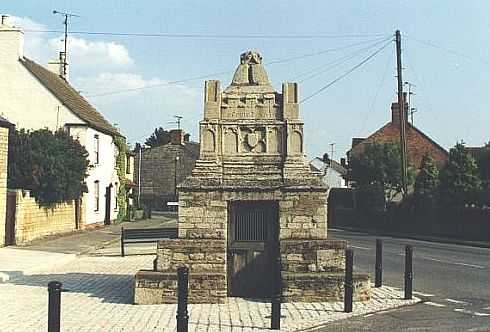|
The
Deeping Lockup
The ancient lockup at Deeping St James
was refurbished in the spring of 1999 at a cost of almost £20,000. The money, which
came from South Kesteven District Council, local charities and various grants,
was well spent because it will not only ensure the survival of this historic curiosity but also attract more visitors to the village that already has a goodly share of heritage sites.
The lockup, situated on the corner of Eastgate and Church Street, was originally the market cross, built of Barnack rag, a local limestone quarried from the small village near Stamford where the Romans obtained their supplies and which also provided stone for a succession of churches in the vicinity including Peterborough Cathedral. It was erected
in the 15th century when Deeping St James held regular markets and such structures
became a feature of most market places in England from where visiting monks could preach to the gathered crowd and to provide a constant reminder to all who did business there that God was present and overseeing all of their transactions. This was a focal point where crowds would gather and so it also became a popular place for the sale of poultry and produce, butter and cheese, hence the more familiar name of the butter cross.
But in 1819, the Deeping market cross was converted for use as the village round house or lockup because there was sufficient space within the base for its new use. The work was carried out by a local craftsman Tailby Johnson at a cost of nine
shillings (£40 in today's values). The interior is five feet square and contains three stone alcoves for seats that were fitted with manacles and chains to secure felons who were ordered to be incarcerated there.
The Deeping lockup was one of many tiny houses of correction that began to appear throughout the country in the late 18th century, near to the church, on the village green or close to ale houses. They were purpose built single-cell prisons where drunks, vagrants and other petty offenders were locked up overnight before appearing before the magistrates next morning. They were sometimes known as guard houses or round houses but whatever their shape, they were all "blind" houses because they had no windows, only grilles high in the walls or set in the doors for ventilation as here at Deeping.
There were also many local names for them, often derogatory, including the blind house or cooler, terms that persist today in connection with over indulgence in alcohol. Blind drunk, for instance, was a description for any suitable candidate for the blind house and hotheads liable to cause trouble faced the prospect of a spell in the lockup where they could cool down and tales are still told in many villages that have a lockup of temporary inmates being supplied with liquor and pipes of tobacco by relatives. The responsibility for these tiny, temporary prisons was that of the parish constable whose duty it was to hold offenders overnight and until they were built, he was often obliged to take them into his own home for safe keeping, which often created a most awkward domestic situation.
|
This
is how
the
Deeping
lockup
looked
before
renovation
work
was
carried
out
in
1999
at
a cost
of
£20,000. |
 |
The renovation scheme required approval from the Department of the Environment because the lockup is a
Grade I listed structure. It was badly needed, not least the removal of an unsightly electric lamp that defaced the top of the monument for so many years. The stonework was cleaned and re-pointed, cobbled setts laid around it and floodlighting installed to provide illumination at night, a seat installed
and a line of black metal bollards to protect the lockup from passing vehicles. Villagers have confessed that in the past, when visitors came to stay, they were ashamed to take them to see the lockup because of its dejected appearance. They now have reason to be proud of this monument that has been refurbished with such sympathy and care that it should last for another six hundred years.
Return
to Deeping St James

Go to:
Main Index Villages
Index
|

